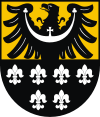Trzebnica
| Trzebnica | ||
|---|---|---|
|
Night view of Trzebnica | ||
| ||
 Trzebnica | ||
| Coordinates: 51°18′18″N 17°3′41″E / 51.30500°N 17.06139°E | ||
| Country |
| |
| Voivodeship | Lower Silesian | |
| County | Trzebnica County | |
| Gmina | Gmina Trzebnica | |
| Government | ||
| • Mayor | Marek Długozima | |
| Area | ||
| • Total | 8.36 km2 (3.23 sq mi) | |
| Highest elevation | 210 m (690 ft) | |
| Lowest elevation | 160 m (520 ft) | |
| Population (2006) | ||
| • Total | 12,180 | |
| • Density | 1,500/km2 (3,800/sq mi) | |
| Time zone | CET (UTC+1) | |
| • Summer (DST) | CEST (UTC+2) | |
| Postal code | 55-100 | |
| Car plates | DTR | |
| Website | http://www.trzebnica.pl | |
Trzebnica (Polish pronunciation: [tʂɛbˈɲit͡sa]; German: Trebnitz, Czech: Třebnice) is a town in Lower Silesian Voivodeship in south-western Poland. It is the seat of Trzebnica County, and of the smaller administrative district (gmina) called Gmina Trzebnica. Prior to 1945 it was in Germany. (For more information about the history of the region, see Silesia.)
The town lies within the eastern Trzebnickie Hills in the historic Lower Silesia region, approximately 20 kilometres (12 mi) north of the regional capital Wrocław. As at 2010, it has a population of 12,460.
History
In the 12th century, the area was among the possessions of the Premonstratensian St. Vincent monastery at Wrocław. Trzebnica itself was first mentioned in an 1138 deed, then held by the Polish voivode Peter Wlast and later seized by the Silesian duke Władysław II the Exile.
In 1202 Władysław's grandson Duke Henry I the Bearded of Silesia and his wife Hedwig of Andechs founded a Cistercian convent, present-day Sanctuary of St. Jadwiga in Trzebnica, the first in Poland. The couple signed the deed of donation on 23 June 1203 in the presence of Hedwig's brother Ekbert Bishop of Bamberg; the monastery was settled with German nuns descending from Bamberg in Franconia. In 1218 Hedwig's daughter Gertrude became abbess of Trzebnica, the first of many Piast princesses to hold this office. After Duke Henry died in 1238 and was buried in the church, his widow moved to the Cistercian convent which by now was led by her daughter. Hedwig died in October 1243 and was buried there also, while some of her relics are preserved at Andechs Abbey in Bavaria, she was canonized in 1267.

In 1250 Trzebnica received town privileges, it passed under the jurisdiction of the Lower Silesian Duchy of Oels in 1323, a Bohemian fief from 1328. In 1480 Duke Konrad X the White granted the town to the Cistercian abbey. Town and monastery were devastated several times, by fires as well as by the plague, but also by Hussite troops in 1430. During the Thirty Years' War, Trebnitz was plundered by Swedish forces and the nuns had to flee across the border to nearby Poland. After the war the premises were rebuilt in its present Baroque style.
In 1742 Trebnitz with most of Silesia was annexed by the Kingdom of Prussia and the monastery was finally securalized in 1810. Meanwhile, the town had become a centre of cloth manufacturing. In 1870 the Order of Saint John acquired the former abbey's estates to establish a hospital, cared for by the Sisters of Mercy of St. Borromeo up to today. The town was heavily damaged during the Vistula–Oder Offensive of the Red Army in the last days of World War II.
International relations
Trzebnica is twinned with:
Notable people
- Saint Agnes of Bohemia (1211–1282), daughter of King Ottokar I of Bohemia, educated at Trzebnica Abbey
- Euphrosyne of Greater Poland (1247/50–1298), daughter of Duke Przemysł I of Greater Poland, abbess of Trzebnica from 1278
- Marie Leszczyńska (1703–1768), daughter of King Stanisław I Leszczyński of Poland, queen consort of France (born here)
- Ernst Niekisch (1889–1967), German politician and exponent of National Bolshevism (born here)
- Gila von Weitershausen (born 1944), German actress
External links
- Jewish Community in Trzebnica on Virtual Shtetl
| Wikimedia Commons has media related to Trzebnica. |
Coordinates: 51°18′18″N 17°03′41″E / 51.30500°N 17.06139°E


